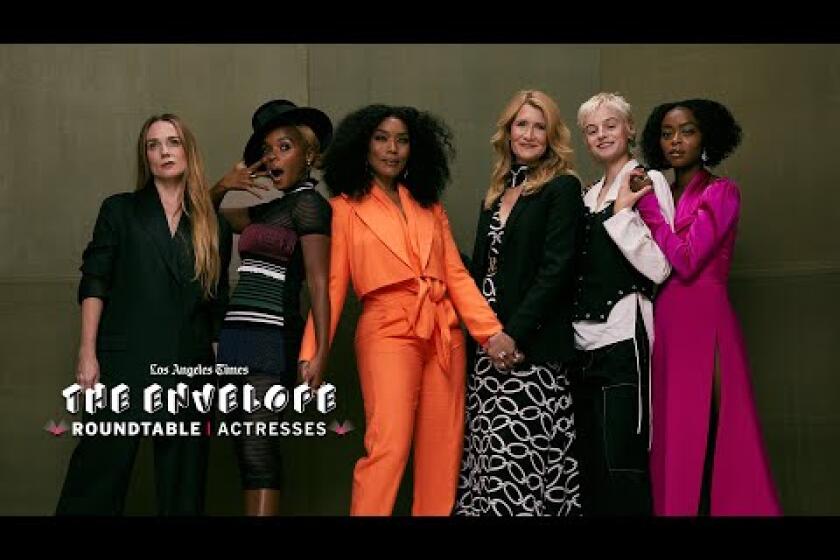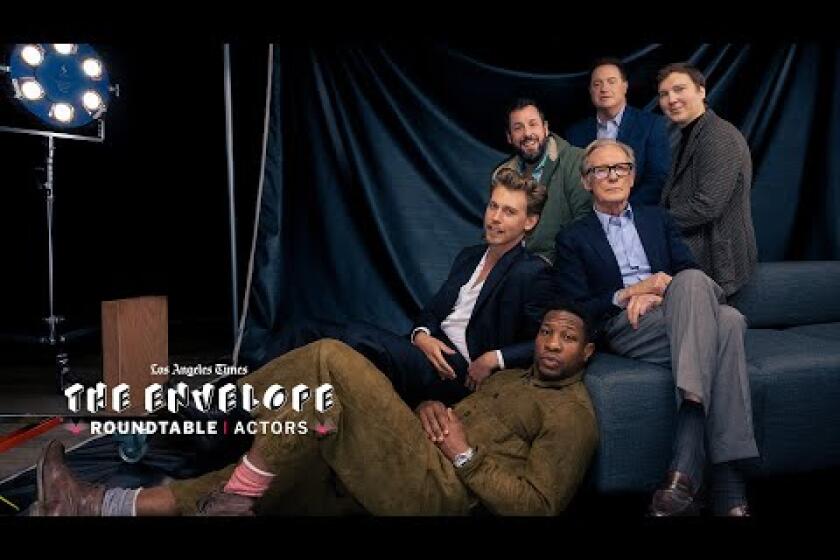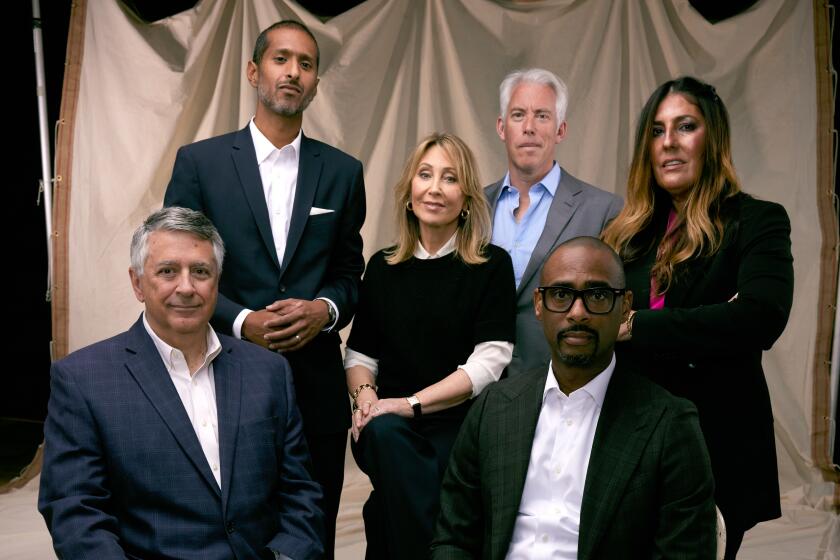From idea to ‘Action!’: Jordan Peele, Rian Johnson, others reveal personal visions

- Share via
Nothing gets a group of directors energized quite like talking about a fruitful collaboration, whether with a stunt coordinator or an actor or cinematographer — even if it means making them fearful.
For Jordan Peele, writer-director of the introspective alien-hunting adventure story “Nope,” working with cinematographer Hoyte Van Hoytema was key. He created a new camera system for day-for-night shooting so that some of the film’s most atmospheric nighttime scenes were actually shot during the day.
“I spoke with Hoyte a lot, and this was probably the first film where I really did talk to the cinematographer like a performer,” Peele says. “And there’s a meta aspect; I have a cinematographer in the film, but also there was so much about this movie that we’re making, we’re doing the same thing these characters are. We’re trying to capture the uncapturable, trying to capture the spectacle.
Bassett, Monáe, Emma Corrin, Kerry Condon, Danielle Deadwyler and Laura Dern open up about the benefits of intimacy coordinators and channeling pain.
“So with Hoyte, when he’s operating the camera, I needed him to sort of feel the fear; we wanted to have a little bit of that sensibility how ‘Jaws’ feels,” Peele says, “they’re just hanging on by their fingernails to stay on the boat and catch [the shark]. So we wanted to have this feeling like it’s just as hard for us to get this shot of the UFO as it is for our characters.”
Other collaborations are far less tangible. “It feels like kind of putting a frame around smoke,” “Glass Onion: A Knives Out Mystery” filmmaker Rian Johnson says of writer-director Charlotte Wells’ evocative, ephemeral father-daughter drama “Aftersun,” a story rooted in memory.
Wells notes that she tends to write visually and had a lot of shots planned out but was also prepared to throw everything away for something else if inspiration struck on the set.
“I feel like the extreme preparation is what allows you to roll with the extreme punches,” Wells says. “Because our plan, I mean, it’s really semantic — we have no rules, but we had strategies.”
Maria Schrader, director of “She Said,” an adaptation of the book by reporters Jodi Kantor and Megan Twohey on how they broke the Harvey Weinstein sexual abuse story, worked with cinematographer Natasha Braier and credits her with making the film’s visuals a much more compelling part of the storytelling.
Six Oscar contenders -- Austin Butler, Paul Dano, Brendan Fraser, Jonathan Majors, Bill Nighy and Adam Sandler -- talk about family, playing real people ... and mortality.
“It’s incredible if [directors of photography] really insist on talking character,” Schrader says. “Natasha Braier, sometimes she would say, ‘No, this frame doesn’t work for that emotion.’ And we would basically only talk about relation and character. I found that so wonderful actually, to be in a scene I would not only talk to the actors about but she and I, we would agree on this is what the scene is about.”
“It’s fun to make a leap together,” agrees “The Woman King” director Gina Prince-Bythewood, who worked with cinematographer Polly Morgan on the historical action drama. “This was a bigger film for her as well. And I say this a lot, but Rian was gracious enough to invite me to the set of ‘Star Wars [Episode VIII — The Last Jedi]’ and I had asked him, ‘How do you not get overwhelmed by the bigness of all of this?’ And he said that it doesn’t matter how much money you have and how big it has to be, you have to always start with story. And I’ve never forgotten that.
“That certainly drove this film, because when you read these things on the page, it is like, ‘How am I gonna capture that?’ But when you start to break down what it’s about, then it’s exciting, because you’re creating something character-based, you’re creating an emotion. And with Polly, it’s so fun to just be locked together, just talking about what is this going to feel like, what is this going to look like?”
These five directors took part in a late-October conversation at the Envelope Directors Roundtable along with French writer-director Florian Zeller, an Oscar winner for the screenplay of “The Father,” who is now back with an adaptation of his own play, “The Son.”
Their conversation here has been edited for length and clarity.
Jordan, “Nope” is both this enigmatic, challenging story about exploitation and a rousing adventure epic. What made you want to explore the tension between those two things?

Jordan Peele: I don’t think I necessarily knew what I was setting out to do. I designed the film, first and foremost [because] I wanted to make a big spectacle. And then in building the script, I basically indicted myself. I looked at what it is about people that needs spectacle, that’s addicted to spectacle.
What I found was the layers underneath the story I was trying to tell was really about exploitation in this industry, what we’re willing to do to seek out and sort of monetize the spectacle. And so all of that was kind of emerging underneath there. At the same time, I come from a comedy background, so at every step of the way I am trying to entertain, I’m trying to make people happy. So that push and pull is just always there.
“Aftersun” is this drama about a father and a daughter on vacation. But there’s something just so enveloping about the film, it really draws audiences in with its visual language. How did you design the flow and feel of it?

Charlotte Wells: I think, talking about lightness in these films, it was really about pulling out the warmth and the joy and the relationship. And one of the things that interested me in this story was the idea of a mutual, joyous, happy, fun, shared experience, and maybe slightly disconnected individual experiences, and that those two things were not necessarily mutually exclusive. And so to feel the individual struggles, particularly of the father, it really had to be intimate and warm. And that needed to be true of that relationship right from the beginning.
I didn’t want it to be about a father and a daughter who were disconnected and found connection over this holiday. I wanted it to be about two people who loved each other very much from the first frame. And I think just focusing on that intimacy kind of led to a certain style and tone that flowed through the rest of the film. And of course, you have this memory structure, which allows you to move a little bit more freely through place and time. But I think, ultimately, it comes down to the intimacy between those two characters.
Rian, I think that it’s easy to get caught up in the story mechanics and the character eccentricities of “Glass Onion” and its predecessor, “Knives Out,” but my impression is that these movies are very personal to you, and I’m wondering where that comes from and how it is that you’re able to enact that in these stories.

Rian Johnson: That’s kind of just an essential element of anything. I’m not sure how any of us could jump into the amount of work it takes to do one of these things and not have something that you deeply care about at the heart of it. For me, even in something like this, where it’s woven hopefully into the texture of what’s a grand entertainment, first and foremost, it’s got to be there.
The whole starting point for these mystery movies was being a huge fan of the genre, but also feeling like any time I would watch them, they would be period pieces set in England. And the murder mystery by its nature is such a brilliant delivery device for talking about what’s happening. It’s a brilliant little fishbowl microcosm encased in this kind of candy shell of a fun mystery.
It felt like a gun without bullets, just the fact that we weren’t using it to kind of talk about what’s actually happening right now. So that was kind of the starting point for “Knives Out.” Not just in like a message way talking about political or societal stuff or anything like that, but also just personal the way that the first movie is very much about politics and family and how the political has become so personal for all of us magically within the past years. So it’s all baked in there, but the fact is that the genre itself is kind of designed to do that, and I didn’t feel like it had been doing that for a while.
Florian, even in a drama like “The Son,” there still are lighter moments. I’m thinking specifically of Hugh Jackman dancing to “It’s Not Unusual.” Are you conscious of wanting there to be lighter moments in a dark story, or do those just sort of naturally come out?

Florian Zeller: That was at least a funny moment for us to shoot, because Hugh Jackman is such a great dancer, but he was supposed to have a slightly embarrassing dancing, so we discovered that to pretend not to know how to dance, you need to be a very good dancer. The day we shot that scene, he came to me and said, “So I thought about an embarrassing movement.” And he did it in front of everyone, and I said, “Try harder.” And so he tried harder, and at some point we find his hip sway.
But it’s true that to me to entertain comes more from the relationship you try to create with the audience. I come from theater, and I’ve spent so many years in a theater feeling, experiencing the sharing of the emotion. And I think this is what is the most entertaining as a viewer, is when you are really part of the story, when you’re in an active position, trying to experience the feelings and the journeys of the character. So I think that even though you are in a tragedy, it can be compelling and entertaining just to experience something that is not your experience but becomes your experience, thanks to a movie.
Gina, “The Woman King” is a historical drama, and it’s a very exciting action film. Sometimes there’s character bits, story moments happening during the action sequences. Is that a hard balance to strike?

Gina Prince-Bythewood: I think it goes back to my pitch for the film, which was “intimately epic.” And explaining to the studio what that means is really I wanted the quiet character moments to be as seismic as the set pieces and make sure that everything flows into each other. I feel like, you know, great action is character-based and story-based, and you have to care about the characters to care about the action. There’s got to be stakes. So that was the fun part, to plant seeds with the characters that then show up, like the rope, she’s having an issue with the rope. And by the end she’s using it as a pretty cool weapon.
Johnson: Gina, how do you — I feel like especially today, so many times you see battle scenes, you can feel the choreography. With your battle scenes, they felt so just raw and fierce and wild. And I was watching, I’m just like, “How do you do this? How do you choreograph it?” You could look at anyone in the background and it’s a holy s— moment of they actually look like they’re about to kill each other. How do you approach it?
Prince-Bythewood: Foremost, I had an incredible collaborator. Danny Hernandez was my fight coordinator, and I met him on “The Old Guard.” I think he’s a genius. And the beauty of it is every sequence that we talked about it started with character. What is happening with its character? What are we revealing? And then we would build the fighting around that, the style of fighting, what was happening in the frame. And I think that also helps make it smaller, because if you think about, “Oh, I’m going to shoot this huge battle.” It becomes overwhelming. But we ended up breaking it into vignettes, and so each character had their own vignette.
The story of “She Said” is based on the book, and these are real events dealing with people who are still living. Did you feel that there was room for any kind of dramatic license, or were you married to the facts of the story?

Maria Schrader: Coming from Europe, I was amazed what was possible, to use all these names, to use all these stories. And there was [producer] Dede Gardner, kind of the mother of this project. I was sent probably the third draft of the script, so she had already extensively talked to the survivors, to the New York Times, to people involved, to Rebecca Lenkiewicz, the scriptwriter.
We adapted things here and there, also for locations. There are a lot of layers of truth there, and we tried to stick to the source material as closely as we could. At the same time [the book] is a pure factual report. It’s a journalistic report of how this story came about. And the film adds what’s left unwritten, the silence between the words, the doubts, the feelings and the emotion. And of course there you step away from factual realness and it becomes interpretation and creation and atmosphere.
And, yes, I felt I very much had that freedom. But the journalists were involved. It’s a very unusual collaboration [with them and] also the survivors. All these testimonies are the wording of the very people. They were shown scenes, we had people from the New York Times helping us in all these details, Megan and Jodi being so generously tireless in the dialogue with us. It was an ongoing dialogue which was extensive, beautiful, sometimes overwhelming. But I think we agreed, at the core, it was about portraying what’s there and not overdramatizing. And not focusing too much on the entertainment pressure. That’s how we generally maybe approached it.
Executives from Sony Pictures, Paramount Global, Blumhouse, CAA and other companies joined The Times for a wide-ranging panel discussion of issues causing anxiety in the entertainment business.
Prince-Bythewood: Talking about the truth, can you talk about how you have Ashley Judd in there too? Her involvement, was she there from the beginning, or was it like you had to get that yes?
Schrader: She was talking on stage at the New York Film Festival, and she said it was very easy for her and she had wanted to do that. It’s almost like in the theater you pull down the fourth wall. She’s playing herself; she’s telling her story. And that is also taking ownership of, “This is the way I want to portray myself and how I lived through that and I want to contribute to this whole project.”
Jordan, you wrote “Nope” with Keke Palmer and Daniel Kaluuya in mind. What was it about them that made them right for this project?
Peele: They’re just two of the best actors I’ve ever seen. And yet I did feel like I had characters for them that would be my favorite characters to see them portray. Both Daniel’s character, OJ, and Keke’s character, Emerald, sort of represent two sides of myself in a way. There’s the guy that sort of is afraid of attention, that sort of wrote “Get Out” because I have a fear of too much attention. And then there’s the Keke version, there’s the “Key and Peele” me that wants nothing more than to dress up in prosthetics and dance in front of the world. And so I’m just kind of a dualistic character, and I think if you put them together, that’s, like, my ideal self.
More to Read
From the Oscars to the Emmys.
Get the Envelope newsletter for exclusive awards season coverage, behind-the-scenes stories from the Envelope podcast and columnist Glenn Whipp’s must-read analysis.
You may occasionally receive promotional content from the Los Angeles Times.














